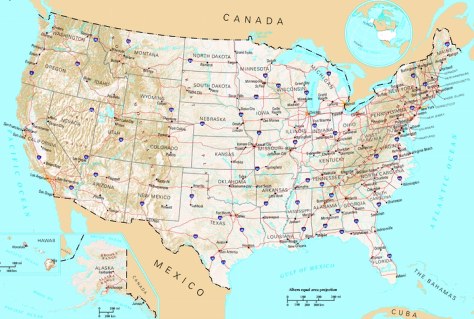United States of America
Travel The World
New York City, officially named the City of New York, is the most populous city in the United States, and the most
densely populated major city in North America..Learn more
American Presidents (View list) and
The 50 states of the United States The 50th state is Hawaii (View list) Visit this page
USA Congress
Find elected officials, including the president, members of Congress, governors, state legislators, local officials, and
more. Go here for links


Images. Map of the USA. San Francisco. There are 43 hills in San Francisco. Broadly, the higher up you live, the more
successful or wealthy you are.
Country name:
United States or United States of America ( US or USA). The United States is commonly called America
and it's people Americans
Capital:
Washington, DC
Nationality:
American
Ethnic groups:
white, black, Asian, Amerindian and Alaska native, native Hawaiian and other Pacific islander
note: a separate listing for Hispanic is not included because the US Census Bureau considers Hispanic to mean a
person of Latin American descent (including persons of Cuban, Mexican, or Puerto Rican origin) living in the US who
may be of any race or ethnic group (white, black, Asian, etc.)
Religions:
Protestant, Roman Catholic, Mormon, Jewish, Muslim, others.
Languages:
English, Spanish, other Indo-European, Asian and Pacific island.
History of the United States of America ( Brief introduction)
1 Pre-Colonial America
Archeologists believe the present day United States was first populated by people migrating from Asia
2 Early European exploration and settlements
One recorded European exploration of the Americas was by Christopher Columbus in 1492, sailing on behalf of the
King and Queen of Spain. After a period of exploration by various European countries, Dutch, Spanish, English, French,
Swedish, and Portuguese settlements were established.
Columbus was the first European to set foot on what would
one day become U.S. territory when he came to Puerto Rico in 1493; the oldest continuously occupied European
settlements in the U.S. are San Juan, Puerto Rico, founded 1521, and on the mainland, St. Augustine in what is now
the state of Florida, founded in 1565.
3 Spanish exploration and settlement
Spaniards pioneered the present-day United States, too. The first confirmed landing in the continental US was by a
Spaniard, Juan Ponce de León, who landed in 1513 at a lush shore he christened La Florida.
The Spanish did not just explore; they settled, creating the first permanent European settlement in the continental
United States at St. Augustine, Florida, in 1565. Santa Fe, New Mexico also predates Jamestown, Virginia and
Plymouth Colony (of Mayflower and Pilgrims fame). Later came Spanish settlements in San Antonio, Tucson, San
Diego, Los Angeles and San Francisco, to name just a few.
4 Colonial America (1493-1776)
The first truly successful English colony was established in 1607, on the James River near the Chesapeake Bay.
The settlement was named Jamestown after the king. England.
As increasing numbers of settlers arrived in Virginia, many conflicts arose between the Native Americans and the
colonists. The colonists increasingly appropriated land to farm and grow tobacco.New England was founded by two
separate groups of religious dissenters. A second group of colonists called the Puritans established the Massachusetts Bay Colony in 1629.
The Middle Colonies, consisting of the present-day states of New York, New Jersey, Pennsylvania, and Delaware,
were characterized by a large degree of diversity. The first attempted English settlement south of Virginia was the
Province of Carolina, with Georgia Colony the last of the Thirteen Colonies established in 1733.
5 Formation of the United States (1776-1789)
The United States celebrates its founding date as July 4, 1776, when the Second Continental Congress—
representing thirteen British colonies—adopted the Declaration of Independence that rejected British authority in
favor of self-determination.
6 Westward expansion (1789–1849)
In 1830, Congress passed the Indian Removal Act, which authorized the president to negotiate treaties that
exchanged Indian tribal lands in the eastern states for lands west of the Mississippi River. This established Andrew
Jackson, a military hero and President, as a cunning tyrant in regards to native populations. The act resulted in the
Chickasaw and Choctaw tribes dying en route to the West, the Creek's violent opposition and eventual defeat, and the
Cherokee Nation taking up farming and "civilized behavior."
7 Civil War era (1849–1865)
In the middle of the 19th century, white Americans of the North and South were unable to reconcile fundamental
differences in their approach to government, economics, society and African American slavery. Abraham Lincoln
was elected President, the South seceded to form the Confederate States of America, and the Civil War followed,
with the ultimate defeat of the South.
8 Reconstruction and the rise of industrialization (1865–1918)
After the Civil War, America experienced an accelerated rate of industrialization, mainly in the northern states.
However, Reconstruction and its failure left the Southern whites in a position of firm control over its black population,
denying them their Civil Rights and keeping them in a state of economic, social and political servitude.
9 Post-World War I and the Great Depression (1918–1940)
During most of the 1920s, the United States enjoyed a period of unbalanced prosperity: farm prices and wages fell,
while industrial profits grew. The boom was fueled by a rise in debt and an inflated Stock Market. The Stock Market
crash in 1929 and the ensuing Great Depression led to government efforts to re-start the economy and help its victims,
with Roosevelt's New Deal. The recovery was rapid in all areas except unemployment, which remained fairly high until
1940.
10 World War II
11 Cold War beginnings and the Civil Rights Movement (1945–1964)
Following World War II, the United States emerged as one of the two dominant superpowers. The U.S. Senate, on
December 4, 1945, approved U.S. participation in the United Nations (UN), which marked a turn away from the traditional
isolationism of the U.S. and toward more international involvement. The post-war era in the United States was defined
internationally by the beginning of the Cold War.
12 Cold War (1964–1980) 13 End of the Cold War (1980–1988) 14 1988–present
The Cold War continued through the 1960s and 1970s, and the United States entered the Vietnam War, whose growing
unpopularity fed already existing social movements, including those among women, minorities and young people.
President Lyndon Johnson's Great Society social programs and the judicial activism of the Warren Court added to the
wide range of social reform during the 1960s and 70s. The period saw the birth of feminism and the environmental
movement as political forces, and continued progress toward Civil Rights.
End of the Cold War (1980–1988)
When Mikhail Gorbachev came to power in Moscow many conservative Republicans were dubious of the friendship
between him and Reagan. Gorbachev tried to save Communism in Russia first by ending the expensive arms race
with America, then (1989) by shedding the East European empire. Communism finally collapsed in Russia in 1991.
1988–present
After the fall of the Soviet Union, the United States emerged as the world's sole remaining superpower and continued
to involve itself in military action overseas, including the 1991 Gulf War.
At the beginning of the new millennium, the United States found itself attacked by Islamist terrorism, with the
September 11, 2001 attacks on the World Trade Center and The Pentagon orchestrated by Osama bin Laden.
Source: Wikipedia, the free encyclopedia.